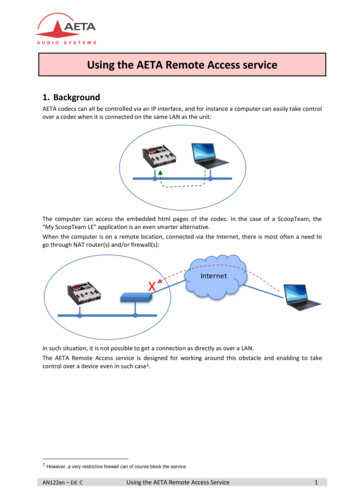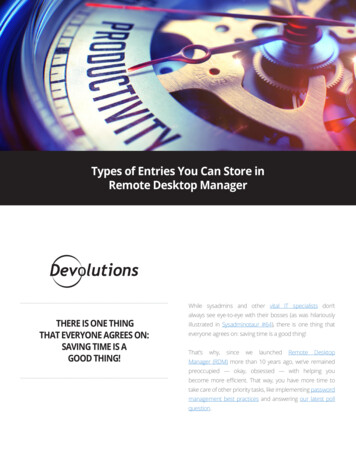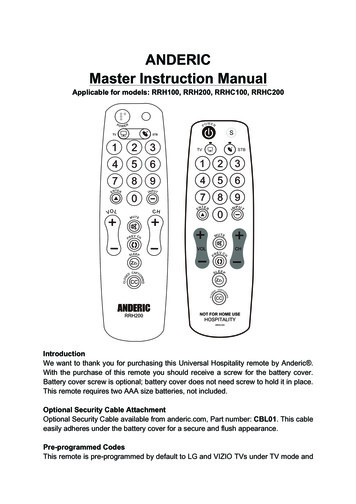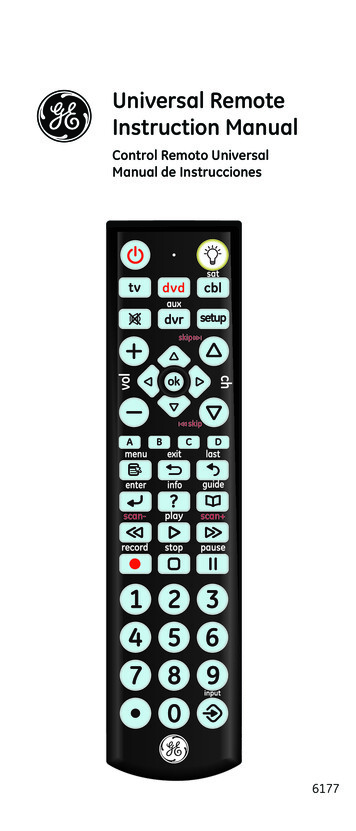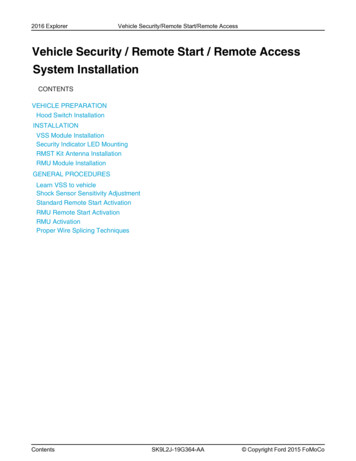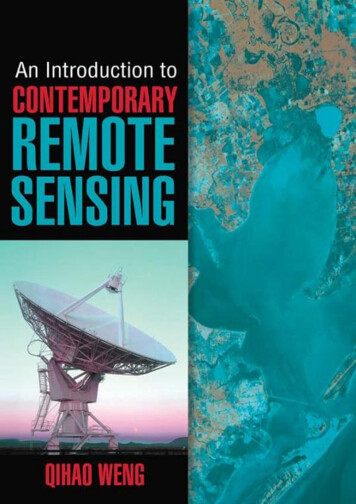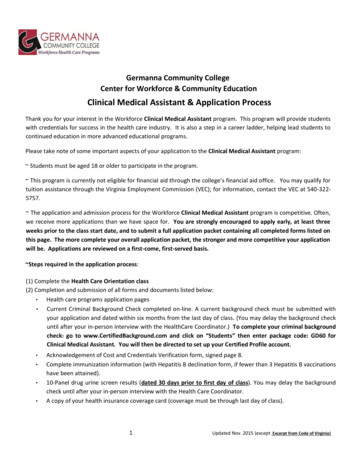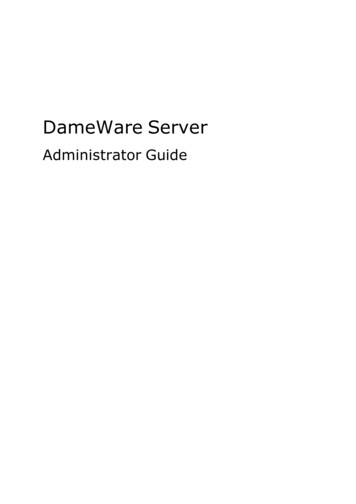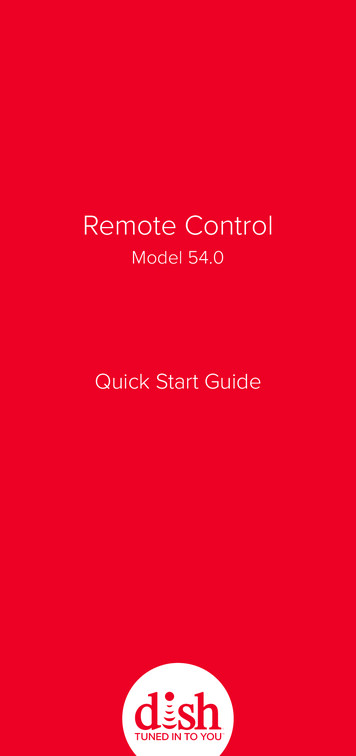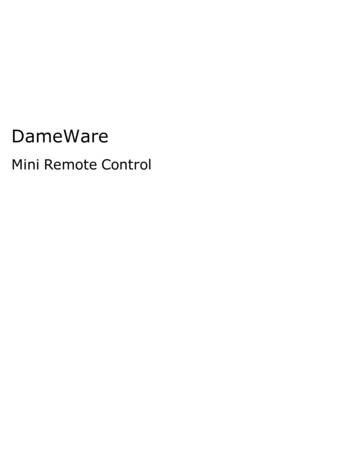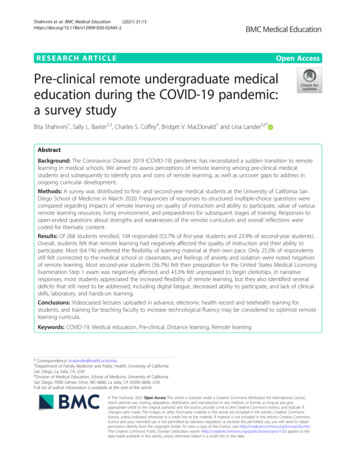
Transcription
Shahrvini et al. BMC Medical Education(2021) EARCH ARTICLEOpen AccessPre-clinical remote undergraduate medicaleducation during the COVID-19 pandemic:a survey studyBita Shahrvini1, Sally L. Baxter2,3, Charles S. Coffey4, Bridget V. MacDonald1 and Lina Lander5,6*AbstractBackground: The Coronavirus Disease 2019 (COVID-19) pandemic has necessitated a sudden transition to remotelearning in medical schools. We aimed to assess perceptions of remote learning among pre-clinical medicalstudents and subsequently to identify pros and cons of remote learning, as well as uncover gaps to address inongoing curricular development.Methods: A survey was distributed to first- and second-year medical students at the University of California SanDiego School of Medicine in March 2020. Frequencies of responses to structured multiple-choice questions werecompared regarding impacts of remote learning on quality of instruction and ability to participate, value of variousremote learning resources, living environment, and preparedness for subsequent stages of training. Responses toopen-ended questions about strengths and weaknesses of the remote curriculum and overall reflections werecoded for thematic content.Results: Of 268 students enrolled, 104 responded (53.7% of first-year students and 23.9% of second-year students).Overall, students felt that remote learning had negatively affected the quality of instruction and their ability toparticipate. Most (64.1%) preferred the flexibility of learning material at their own pace. Only 25.5% of respondentsstill felt connected to the medical school or classmates, and feelings of anxiety and isolation were noted negativesof remote learning. Most second-year students (56.7%) felt their preparation for the United States Medical LicensingExamination Step 1 exam was negatively affected, and 43.3% felt unprepared to begin clerkships. In narrativeresponses, most students appreciated the increased flexibility of remote learning, but they also identified severaldeficits that still need to be addressed, including digital fatigue, decreased ability to participate, and lack of clinicalskills, laboratory, and hands-on learning.Conclusions: Videocasted lectures uploaded in advance, electronic health record and telehealth training forstudents, and training for teaching faculty to increase technological fluency may be considered to optimize remotelearning curricula.Keywords: COVID-19, Medical education, Pre-clinical, Distance learning, Remote learning* Correspondence: linalander@health.ucsd.edu5Department of Family Medicine and Public Health, University of CaliforniaSan Diego, La Jolla, CA, USA6Division of Medical Education, School of Medicine, University of CaliforniaSan Diego, 9500 Gilman Drive, MC-0606, La Jolla, CA 92093-0606, USAFull list of author information is available at the end of the article The Author(s). 2021 Open Access This article is licensed under a Creative Commons Attribution 4.0 International License,which permits use, sharing, adaptation, distribution and reproduction in any medium or format, as long as you giveappropriate credit to the original author(s) and the source, provide a link to the Creative Commons licence, and indicate ifchanges were made. The images or other third party material in this article are included in the article's Creative Commonslicence, unless indicated otherwise in a credit line to the material. If material is not included in the article's Creative Commonslicence and your intended use is not permitted by statutory regulation or exceeds the permitted use, you will need to obtainpermission directly from the copyright holder. To view a copy of this licence, visit http://creativecommons.org/licenses/by/4.0/.The Creative Commons Public Domain Dedication waiver ) applies to thedata made available in this article, unless otherwise stated in a credit line to the data.
Shahrvini et al. BMC Medical Education(2021) 21:13BackgroundThe Coronavirus Disease 2019 (COVID-19) pandemichas disrupted countless aspects of economy, society, andhealth. Medical schools have been challenged by theabrupt transition to remote learning, enacted to protectpatients and students. With the unprecedentedcancellation of in-person classes, small groups, and clinical experiences, this study aims to assess the relativesuccesses and areas for improvement in a preclinical remote learning curriculum.On March 16, 2020, the University of California SanDiego (UCSD) School of Medicine (SOM) announced thatall pre-clinical education would be conducted completelyonline and remotely. Prior to this announcement, thestandard pre-clinical curriculum consisted of lecture-basedorgan system blocks, problem-based learning small groups,laboratory-based classes such as anatomy, histology, andultrasound, and various pre-clinical electives. Clinical exposures included a course in doctoring/humanism (“Practiceof Medicine”) and longitudinal ambulatory care apprenticeships, where students participated in weekly clinics withfaculty mentors. Table 1 details these curricular components and changes associated with the remote learningtransition. These changes were made abruptly in responseto public health regulations and state-mandated orders [1]rather than being motivated by deliberate theoretical orconceptual pedagogical frameworks.Remote learning has gained popularity in higher education over the last decade [2–8]. Medical schools haveincreasingly utilized videocasting and virtual learningplatforms to afford greater flexibility for students [9–15].However, integration of technology and flexible remotePage 2 of 13learning options into medical curricula has historicallybeen relatively slow [16–20]. While students have hadthe option to view lectures online and purchase optionalremote learning resources (e.g. question banks, videosubscription services, and flashcards) [21], most preclinical knowledge was still disseminated in-person.Nonetheless, videocasted lectures and virtual learningplatforms have impacted the way students engage withand participate in curricula, both of which are keyaspects of health professions education according to thesocial learning perspective of situated learning theory[22]. The sudden and complete transition to remotelearning necessitated by COVID-19 required rapid development of remote learning curricula to meet complexlearning objectives. Rooted in the cognitive learning theory, we aimed to continue empowering learners with thenecessary tools to progressively master fundamentalknowledge in the pre-clinical curriculum [23].The goals of this study were to better understand the effects of this complete transition to remote learning duringthe COVID-19 pandemic on pre-clinical students. Toachieve this, we developed and deployed a survey of firstand second-year UCSD medical students. Because of thenovelty and unprecedented nature of this transition, thiswas a hypothesis-generating study. The survey was motivated by an initial exploratory approach and entailed a widearray of survey items, including open-ended items, to evaluate student perspectives around this transition. By doing so,our goals were to better understand the relative successesand failures of the remote learning experience and to subsequently inform best practices for curriculum design, evenafter the COVID-19 pandemic resolves.Table 1 Summary of UCSD School of Medicine pre-clinical curriculum before and after the transition to remote learningRemote Learning Changes in the UCSD SOM CurriculumBefore the transitionAfter the transitionOrgan SystemBlocks2–4 h of consecutive lectures with videocasts made availablefollowing the in-person lectures.Final Exams taken via Examplify on personal computers oncampus.2–4 h of consecutive videocasted lectures, with all videocastsfor the block uploaded in advance.Final Exams taken via Examplify on personal computers atstudents’ homes.Lab Classes(Anatomy,Histology,Ultrasound)In-person labs with lab manuals posted online in advance ofscheduled lab times.All labs cancelled. Optional, live videoconference office hoursoffered. Manuals posted online in advance of correspondinglab office hours.Practice of Medicine4-h small group sessions every other week.Groups of 8 students and 1 facilitator.In-person practice of physical exam/doctoring skills andstudent encounters with patient actors.4-h videocasted small group sessions every other week.Groups of 8 students and 1 facilitator.No physical exam learning. Videoconference studentencounters with patient actors.Problem BasedLearning2-h in-person small group sessions twice a week to review pa- 2-h videoconference small group sessions twice a week totient cases and present relevant topics.review patient cases and present relevant topics.Groups of 8 students and 1 facilitator.Groups of 8 students and 1 facilitator.Ambulatory CareApprenticeships(ACA)Students paired with a primary care preceptor in San Diegoto practice conducting patient histories, physical exams, andwriting notes.Cancelled.Pre-clinical ElectivesRange from clinical preceptorships to community service tolecture based electives.Some cancelled, others moved to videoconferenceplatforms.
Shahrvini et al. BMC Medical Education(2021) 21:13MethodsStudy populationThis study was conducted at the UCSD School of Medicine, an accredited allopathic medical school in La Jolla,CA. Eligible participants included all medical students enrolled in their first or second year as of March 30, 2020.The UCSD Institutional Review Board (IRB) approved thisprotocol as a quality improvement study. The average agefor UCSD SOM’s entering class of 2019 is 24, with 58% ofstudents being female, and the vast majority being California residents [24]. Students at UCSD engage in a traditional medical curriculum with the first year focused onnormal physiology and basic sciences and the second yearfocused on anatomy, pharmacology, histology, and pathology. Training programs in clinical skills are woventhroughout the pre-clinical curriculum longitudinally. Thepre-clinical curriculum at UCSD SOM is entirely pass/failwith no internal rankings or influence on Alpha OmegaAlpha (AOA) honors society selection, fostering a noncompetitive, tight-knit learning environment among students. Specific curricular components and changesassociated with the remote learning transition are detailedin Table 1.Survey design and implementationWe developed the survey instrument (Appendix 1) basedon prior annual student surveys. We consulted faculty,staff, and students to establish face validity, using a similar process as described in prior studies involving medical student surveys [25]. Students rated the value ofvarious remote learning resources, aspects of curricularstructure, communication from leadership, feelings ofconnectedness, out-of-pocket expenses, and suitability oftheir living environment. For second-year students, thesurvey also asked about preparedness for subsequentstages of training. Finally, open-ended questions askedstudents about telehealth experiences (e.g. healthcare delivery via remote technologies [26] such as virtualdoctor-patient visits conducted over video), strengthsand weaknesses of the remote curriculum, componentsthat should be incorporated into the standard curriculum, and overall reflections.We used an online software platform (Qualtrics,Provo, UT) to distribute the survey via e-mail to all eligible participants. Survey completion required approximately 10 min. The survey was anonymous, optional,and not linked to any student evaluations.Statistical analysesDescriptive statistics were generated using the mean andstandard deviations or counts/frequencies where appropriate, using Microsoft Excel Version 2004 (Microsoft Corporation, Redmond, WA, USA). To assess internal consistencyreliability for structured/closed-ended survey items gradedPage 3 of 13on the same Likert scale, Cronbach’s alpha calculationswere performed using the psych package in R version 3.5.1for each domain of the survey. Open-ended responses werecoded by two independent coders (CC and BS) for thematiccontent. Comments were iteratively reviewed and mappedto various thematic domains. Discrepancies in emergingthemes were reviewed by all co-authors until a consensuswas reached. Representative comments demonstrating themajor themes, chosen and agreed upon by all co-authors,were extracted for illustration. Sample size was based on aconvenience sample of all pre-clinical students at our institution, aiming for rapid data acquisition regarding initial experiences of the remote learning curriculum soon after thetransition. In addition, because we were not conducting ahypothesis-driven study, but rather an initial exploration offeedback to fuel future improvements in a rapidly changingenvironment, we did not perform formal power calculations, given that the sample size was logistically constrainedby existing enrollments/class sizes.Ethical considerationsA key ethical consideration was assuring that studentsfelt free to share honest feedback without any fear of repercussion. Two primary courses of action were taken inthis regard. First, survey completion was entirely anonymous, without linkage of student names or identifying information to responses submitted. Second, thesurvey was optional, with no way to assess who hadcompleted the survey and who had not. At the time ofdistribution, students were informed of both the anonymous and optional nature of the survey. We also informed students that there would be no possibility oflinking their responses to their names and course evaluations. The pass/fail grading system further facilitated anenvironment for students to share direct, unfiltered feedback without fear of impacting their grades.ResultsOf 268 students (134 in each class) invited to participate,104 (38.8%) responded. Respondents consisted of 72first-year students (53.7% response rate among all firstyear students) and 32 second-year students (23.9%).Effects of remote learning on curricular componentsFor all curricular components besides lectures, most students felt the quality of instruction was somewhat orvery negatively affected by the remote learning transition(Table 2). The Cronbach’s alpha for this domain of thesurvey was 0.89 (95% confidence interval 0.86 to 0.92).The highest proportions of students felt that remotelearning had very negatively affected the quality of instruction in anatomy (49/74, 66.2%), ultrasound (39/47,83.0%), and the ambulatory care preceptorship (51/53,96.2%). Students felt that remote learning somewhat or
Shahrvini et al. BMC Medical Education(2021) 21:13Page 4 of 13Table 2 Perceptions of the effects of remote learning on quality of instruction and on ability to participate among pre-clinicalmedical students at the University of California San Diego, March–April 2020. The number of respondents is indicated for eachspecific curricular componentVery negativelyaffectedSomewhat negativelyaffectedNeutralSomewhat positivelyaffectedVery positivelyaffected23 (24.7%)39 (41.9%)12 (12.9%)11 (11.8%)Effect of Remote Learning on Quality of InstructionLecture-based learning (n 93)8 (8.6%)Problem-based learning (n 101)11 (10.9%)41 (40.6%)35 (34.7%)10 (9.9%)4 (4.0%)Practice of Medicine (n 77)38 (49.4%)32 (41.6%)7 (9.1%)0 (0.0%)0 (0.0%)Anatomy (n 74)49 (66.2%)20 (27.0%)4 (5.4%)1 (1.4%)0 (0.0%)Histology (n 74)26 (35.1%)27 (36.5%)15 (20.3%)4 5.41%2 (2.7%)Ultrasound (n 47)39 (83.0%)7 (14.9%)1 (2.1%)0 (0.0%)0 (0.0%)Ambulatory Care Preceptorship (n 53)51 (96.2%)0 (0.0%)2 (3.8%)0 (0.0%)0 (0.0%)Pre-clinical Electives (n 69)30 (43.5%)17 (24.6%)19 (27.5%)3 4.35%0 (0.0%)Effect of Remote Learning on Ability to ParticipateLecture-based learning (n 95)14 (14.7%)17 (17.9%)42 (44.2%)11 (11.6%)11 (11.6%)Problem-based learning (n 101)8 (7.9%)32 (31.7%)46 (45.5%)12 (11.9%)3 (3.0%)Practice of Medicine (n 78)17 (21.8%)30 (38.5%)26 (33.3%)3 (3.9%)2 (2.6%)Anatomy (n 73)38 (52.1%)20 (27.4%)13 (17.8%)1 (1.4%)1 (1.4%)Histology (n 73)33 (45.2%)24 (32.9%)14 (19.2%)1 (1.4%)1 (1.4%)Ultrasound (n 46)37 (80.4%)6 (13.0%)2 (4.4%)0 (0.0%)1 (2.2%)Ambulatory Care Preceptorship (n 53)45 (84.9%)4 (7.6%)3 (5.7%)0 (0.0%)1 (1.9%)Pre-clinical Electives (n 68)25 (36.8%)17 (25.0%)22 (32.4%)2 (2.9%)2 (2.9%)very positively affected other curricular components,such as lecture-based learning (23/93, 24.73%) andproblem-based learning (14/101, 13.9%). However, forthe remaining curricular components, 10% of studentsfelt that the remote learning transition had any positiveeffects.Perceptions of the effects of remote learning on abilityto participate followed similar patterns. Besides lecturesand problem-based learning, where students were neutral about their ability to participate remotely, the majority ( 60%) of students felt remote learning hadsomewhat or very negatively affected their ability to participate in all other curricular components (Table 2).USA) and Aquifer (Aquifer, Lebanon, NH, USA) forclinically-oriented organ system and specialty-specificlearning, and JoVE Science Education (JoVE, Cambridge,MA, USA) for physical exam skills learning. Almost twothirds (66/103, 64.1%) of students preferred having theflexibility of learning material at their own pace rather thanhaving required modules and set due dates. When askedabout the ideal frequency of due dates, most (55/103,53.4%) preferred weekly due dates. Fewer students preferred due dates to occur daily (4/103, 3.9%), every few days(15/103, 14.6%), biweekly (16/103, 15.5%), or monthly (13/103, 12.6%).Costs, living arrangements, and connectednessRemote learning resources and curricular structurePre-clinical students endorsed variable utilization of remotelearning resources (Fig. 1). The Cronbach’s alpha for responses regarding remote learning resources was 0.80 (95%confidence interval 0.75 to 0.86). Resources regarded asvaluable by half or more of respondents included a laptop,tablet, online question bank subscription, recorded didacticlectures, videoconferencing software (Zoom, Zoom VideoCommunications, Inc., San Jose, CA, USA), digital anatomyeducation app (Complete Anatomy, 3D4Medical, Dublin,Ireland), and online office hours and review sessions (Fig.1). Resources of relatively lesser value included online textbooks, Online MedEd (OnlineMedEd, Inc., Austin, TX,For most (72/103, 69.9%) students, transitioning to remote learning incurred less than 100 of additional outof-pocket expenses. However, almost a quarter (24/103,23.3%) spent 101– 500, and there were 7 students(6.8%) who spent over 500 during the remote learningtransition.With remote learning, one-fifth of the students (20/98,20.4%) moved outside the greater metropolitan area surrounding the institution. The remaining students stayed locally, whether in their current housing arrangements (72/98, 73.5%) or moving to different housing nearby (6/98,6.1%). About one-fifth of students (21/98, 21.4%) felt theirliving arrangements were not conducive to remote learning
Shahrvini et al. BMC Medical Education(2021) 21:13Page 5 of 13Fig. 1 Perceptions regarding the value of various remote learning resources among pre-clinical (first- and second-year medical students) at theUniversity of California San Diego, March–April 2020. Students were asked to rate their level of agreement with whether the specific remotelearning resources were valuable for their medical education(Table 3). This was primarily attributed to lack of quietstudy space, a barrier identified by a quarter of students(24/98, 24.5%). Very few students (5/98, 5.1%) indicatedlack of sufficient internet or technology. The responses regarding home learning environments had a Cronbach’salpha of 0.76 (95% confidence interval 0.68 to 0.83).Overall, students felt less connected during remote learning. Only about a quarter of students still felt connected tothe medical school or to their classmates (Table 3).Preparation for subsequent stages of trainingSecond-year students felt that remote learning negativelyaffected their preparation for subsequent stages of training. Over half (17/30, 56.7%) felt that their preparation for the United States Medical LicensingExamination (USMLE) Step 1 examination was negatively affected. About a quarter (7/30, 23.3%) felttheir preparation was positively affected, and the remainder felt their preparation had not changed.Table 3 Living arrangements and feelings of connectedness among pre-clinical (first- and second-year medical students) at theUniversity of California San Diego, March–April 2020Statements(N 98 students)Scale of AgreementStrongly Disagree Neutral AgreeDisagreeStronglyAgreeOverall, my current living arrangements are conducive to remote learning.6 (6.1%)15(15.3%)17(17.4%)4020(40.8%) (20.4%)I have access to sufficient internet to meet the demands of remote learning.1 (1.0%)8 (8.2%)7 (7.1%) 4042(40.8%) (42.9%)I have access to sufficient technology (i.e. a computer with a webcam, iPad, etc) to meet thedemands of remote learning.0 (0%)5 (5.1%)2 (2.0%) 4348(43.9%) (50.0%)Given my living arrangements, I have sufficient access to quiet study space to meet thedemands of remote learning.7 (7.1%)17(17.4%)16(16.3%)3820(38.8%) (20.4%)Given the transition to remote learning, I still feel connected to UCSD School of Medicine.14(14.2%)38(38.8%)21(21.4%)205 (5.1%)(20.4%)Given the transitions to remote learning, I still feel connected to my classmates.20(20.4%)31(31.6%)20(20.4%)261 (1.0%)(26.5%)
(2021) 21:13Shahrvini et al. BMC Medical EducationSimilarly, 13 (43.3%) felt unprepared for clinicalclerkships, 9 (30.0%) felt prepared, and the remainder were neutral.Page 6 of 13environments that were not conducive to studying(Table 5h).II. Remote learning format – digital fatigue andparticipationNarrative resultsFour dominant themes emerged from 254 unique narrative responses to open-ended questions:I. Structure – flexibility and efficiencyMany students praised the increased flexibilityafforded by remote learning. Almost two-thirds (38/59,64.4%) cited increased flexibility as the best part of remote learning (Table 4), noting the benefits of selfpacing, which permitted them to pause and work outdifficult concepts, or to speed up recordings to enhanceefficiency. Many appreciated the opportunity to “getahead” of the lecture schedule via pre-recorded lectures(Table 5a, b). Several students noted they were able tocoordinate studies with their circadian rhythms tooptimize periods of productivity and efficiency (Table5c, d). Students also valued the flexibility to engage inactivities such as research, Step 1 studying, self-care, andvolunteering (Table 5e). Several students praised remotelearning for the time and financial gains from eliminating commutes, either from home to school or from onebuilding on campus to another (Table 5f).By contrast, some students struggled with decreased structure, citing that it was easy to fall behind (Table 5g). When asked specifically about gapsin the remote learning curriculum, 7/61 respondents(11.5%) noted lack of a structured schedule anddisorganization (Table 4). Others conveyed thatproductivity and motivation were hindered by homeProlonged engagement in remote learning formatsproved problematic for many students. Numerous respondents (11/61, 18.0%) specifically reported digital fatigue asa significant drawback of the remote curriculum. Interestingly, some students noted the greatest digital fatigue withsynchronous small group sessions, which were designedto be interactive, but instead led to disengagement, exhaustion, and inability to focus (Table 5i, j). Some respondents felt remote formats hampered participation due totechnical issues and inability to study in groups or effectively use office hours (Table 5k, l). In contrast, some students felt the remote format enhanced small groupinteractions, and 9/54 respondents (16.7%) desired thatvirtual problem-based learning (PBL) be continued beyond the pandemic period (Table 4).III. Content gaps – lab classes and clinical skillslearningUnsurprisingly, when asked specifically about the biggest gaps in the remote learning curriculum, 31/61 respondents (50.8%) cited clinical skills learning (Table 4).Many students noted deficiencies with history-takingand physical exam training. The overall dearth of clinicalskills training left students feeling unprepared for clinicalassessments and encounters (Table 5m, n). Students alsofelt a loss of motivation when clinical training opportunities disappeared (Table 5o). Most students also felt thatTable 4 Free responses among pre-clinical (first- and second-year medical students) at the University of California San Diego,March–April 2020. Best and worst components of the remote learning curriculum and aspects that should be continued in future,hybrid curriculaWhat are the best componentsof the remote curriculum?(N 59)N (%) Which components of the remote curriculumshould be continued in the standard curriculumin the future?(N 54)N (%) What gaps remain inthe remote curriculum?(N 61)N (%)Increased flexibility38Videocasted lectures, uploaded in advance for the(64%) block27Clinical skills learning (POM,(50%) ACA)31(51%)Videocasted lectures, uploaded inadvance for the block18Virtual PBL(31%)9Lab classes (Anatomy,(17%) Histology, Ultrasound)15(25%)Increased efficiency10Increased office hours/review sessions(17%)7Zoom/Digital Fatigue(13%)11(18%)Increased office hours/review sessions4(7%)6Difficult to participate/ask(11%) questions8(13%)Virtual PBL4(7%)Extra resources/practice questionsDisorganization/ Lackingstructured schedule7(11%)Poor communication/Transparency5(8%)
Shahrvini et al. BMC Medical Education(2021) 21:13Page 7 of 13Table 5 Student quotations representative of views expressed by multiple students regarding thematic content of free responsequestionsI. Structure: Flexibility and Efficiencya. “I do not learn well in the physical lecture session bc I cannot pause and address confusion right away.”b. “I appreciate having all the block’s lectures at the beginning so I can watch them at my own pace and get ahead if I choose.”c. “I am an early riser so I do like being able to wake up early and start on lectures by 6 AM.”d. “The ability to learn more or less depending on the energy level of the day is absolutely massive. And has been the STRONGEST addition to myeducation, regardless of the circumstance.”e. “More freedom to productively use my time (research/STEP studying).”f. “I also commute to school so remote learning is saving me a lot of money and time, which I am very happy about.”g. “The biggest killer in remote learning is time self management. I sleep in more than I should and do less work than I should. I would like helpkeeping myself accountable by having more assignments with more set due dates. If the assignments are there, I will do them.”h. “At grad housing, my neighbors above have children who are persistently loud and while at home my large family are all working and always oncalls. Many students feel that it’s difficult to focus, be engaged, and be placed in an environment conducive to learning. As such, a student likemyself who used to never struggle with having motivation to get to work is having more difficulties now than ever to simply be a student.”II. Remote Learning Format: Digital Fatigue and Participationi. “Zoom classes feel much longer online than in person.”j. “POM [Practice of Medicine] for 4 h straight is impossible. Many of the activities are difficult to do over Zoom. Honestly, the past few weeks afterlogging off the 4 h POM zoom call, I have been so discouraged that I couldn’t focus for the rest of the evening. Four hours on a Zoom call isphysically and emotionally draining.”k. “Interaction with faculty and students is simply not the same. It’s a bit hard to describe, but as someone who is very much an “in person” and“tangible” learner, going to lecture and seeing the faculty, speaking with peers, and interacting with everyone in person is more conducive to mylearning style.”l. “It’s very hard to do any sort of group studying. It’s very hard to find a quiet place to study. It’s very hard to learn doctoring skills There is noway to practice your skills/ask questions.”III. Content: Lab Classes and Clinical Skills Learningm. “As someone who learns best through hands on methods, I’m struggling with anatomy and POM and really missing the opportunity to practicepatient interviewing/physical exams during ACA. I do not feel prepared for an OSCE at the end of the year.”n. “As of now I do not feel prepared for step style questions, or comfortable trying to apply my knowledge in relevant clinical settings.”o. “It has also been hard not having clinical experiences, since that was my favorite part of medical school.”p. “Anatomy is extremely difficult to learn remotely - and I know a lot of students who have just resigned to not learning pelvic anatomy given thecircumstances.”q. “(Telehealth participation) has been very valuable and a great learning experience and is helping me stay grounded and connected to my role asa med student.”r. “Telehealth. Was a great learning experience, practiced taking a hx, presenting to attending, writing a note.”s. “(Telehealth participation) has been hugely helpful for my motivation and keeping up with my interviewing skills.”IV. Mental Health: Anxiety and Isolationt. “Being more or less alone for the past 2 months has showed me the importance of connection and social interaction in my own mental wellbeing and the role that our in-person classes served in meeting that need for me. I miss in-person class for that reason the most. And I would beworried that if the SOM switched to more remote learning permanently after COVID-19, a lot of student’s mental health would decline due to isolation and lack of relationships with classmates. “u. “It’s an incredibly isolating experience. mental health is more so a
for each domain of the survey. Open-ended responses were coded by two independent coders (CC and BS) for thematic content. Comments were iteratively reviewed and mapped to various thematic domains. Discrepancies in emerging themes were reviewed by all co-authors until a consensus was reached. Representative comments demonstrating the
